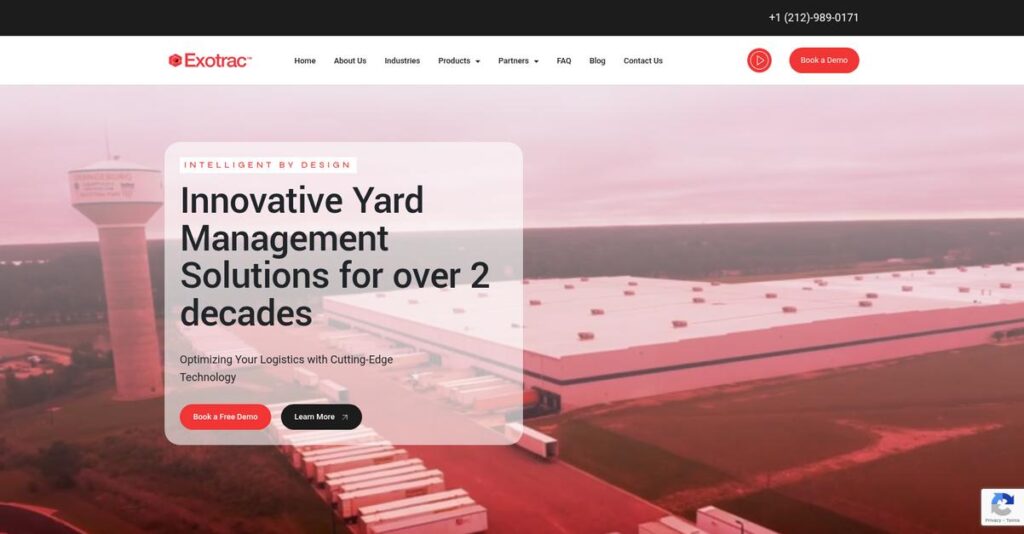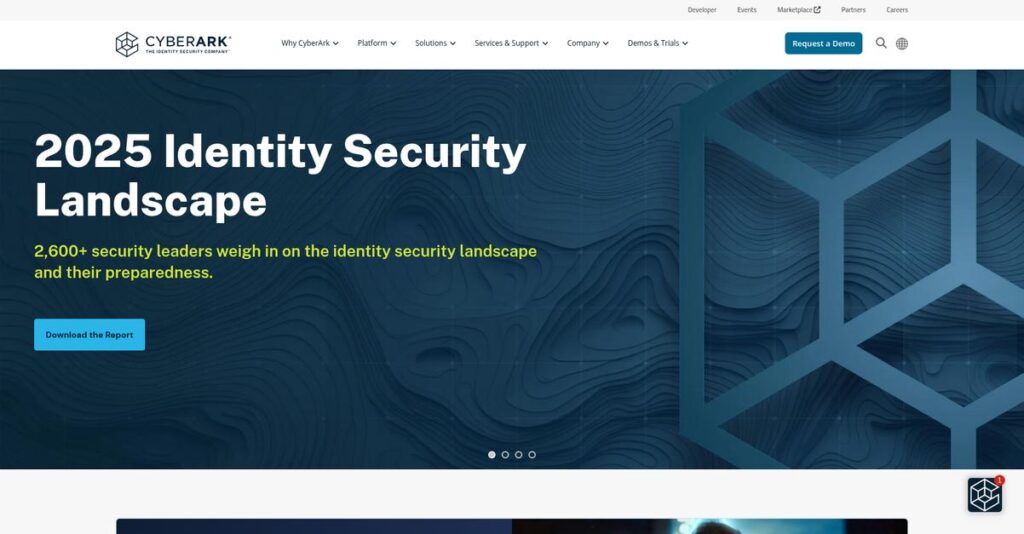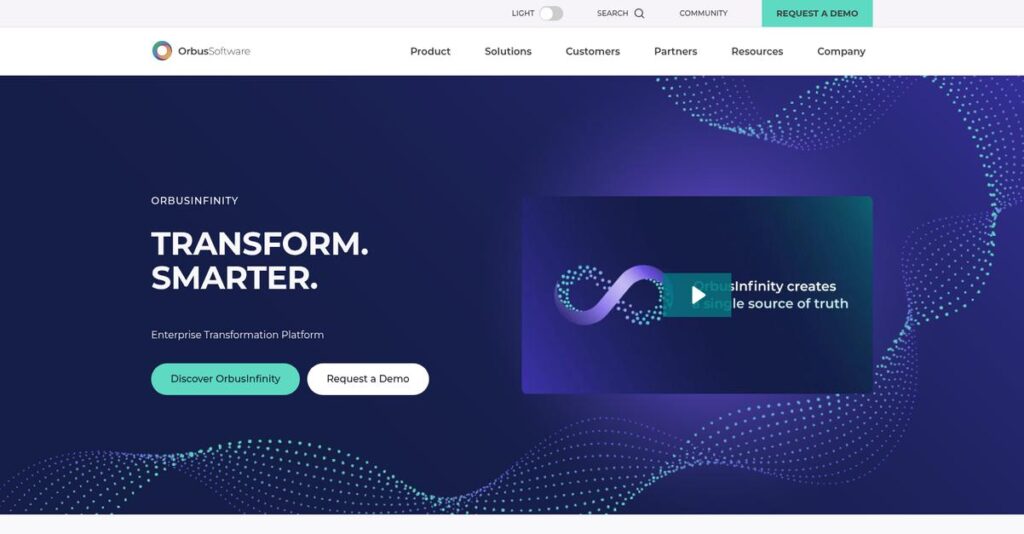Tired of losing trailers in your yard?
If you’re dealing with endless spreadsheets, radio calls, and wasted man-hours tracking assets, it’s no wonder you’re searching for something better than status quo yard management.
After researching the top solutions, my analysis highlights this: manual yard tracking leads directly to lost time and confusion that stall every shipment and frustrate your team.
Exotrac’s all-in-one Yard Management System attacks this by giving you real-time visibility, digital maps, and automation for every asset on-site. What really stands out are their RTLS hardware integrations and mobile-first workflows—this is more than a digital whiteboard.
In this review, I’ll show you how Exotrac can end manual chaos and replace patchwork processes with accurate, real-time control.
Here’s what you’ll find in this Exotrac review: key features in action, their pricing details, real-world use cases, and how Exotrac really stacks up against alternatives in 2025.
You’ll come away knowing the features you need to take yard control seriously and finally make confident software decisions.
Let’s get started.
Quick Summary
- Exotrac is a yard management system that provides real-time visibility and control over trailer and asset movements within your distribution center or plant.
- Best for mid-market to enterprise companies managing complex yard operations with high trailer volume.
- You’ll appreciate its precise RTLS tracking combined with an intuitive interface that reduces trailer searches and detention fees.
- Exotrac offers custom SaaS pricing without a free trial, requiring a demo and personalized quote based on your facility’s needs.
Exotrac Overview
Exotrac has been around since 2016, based in New York. From my research, their mission is to digitize and automate chaotic logistics within your facility’s four walls.
While we’re discussing business operations, understanding best ambulance management software is equally important for healthcare logistics.
What stood out to me is how they focus on mid-market to enterprise businesses with complex logistics operations. You’ll find them a good fit for retail, manufacturing, or food and beverage industries, helping you finally move beyond manual processes.
Recent developments in this Exotrac review show a smart focus on deepening their technology, particularly through partnerships that enhance their real-time location tracking hardware.
Unlike competitors that are purely software-based, what I found is Exotrac’s key advantage is its proprietary hardware and software RTLS combination. This integrated approach provides a more robust and truly accurate asset tracking solution for your yard.
They typically work with well-known mid-sized and large companies in sectors like manufacturing, retail, and CPG who are struggling with inefficient, manual yard management processes.
From my evaluation, Exotrac’s strategy centers on providing unparalleled accuracy through total real-time visibility. This directly addresses your need to eliminate lost trailers, cut costly detention and demurrage fees, and improve turn times by automating manual checks.
Let’s dive into their feature set.
Exotrac Features
Yard operations feel like a constant scramble?
Exotrac provides an integrated suite of modules to help you digitize and automate yard logistics. These are the five core Exotrac solutions that revolutionize how you manage your distribution center or plant.
1. Core Yard Management System (YMS)
Can’t find that one “lost” trailer?
Relying on radios and whiteboards makes tracking assets incredibly frustrating. This operational blindness leads to wasted time and major inefficiencies.
The YMS acts as your central command center, offering a digital map of your entire yard. What I found is you get real-time location and status of every asset. This core solution lets you instantly assign tasks to drivers and monitor progress, cutting down manual checks significantly.
This means you can finally eliminate the “lost trailer” problem, giving your team complete visibility and control over yard activities.
2. Dock Door Scheduling & Appointments
Dock doors constantly congested?
Unscheduled arrivals lead to long driver wait times and inefficient loading. This chaos costs you money in costly detention and demurrage fees.
This Exotrac solution allows carriers and your team to pre-schedule dock appointments through an intuitive web portal. From my testing, automating the confirmation process is key, providing a clear schedule. This helps you match labor and equipment to daily workloads, streamlining flow effectively.
What you get is vastly improved dock utilization, significantly reducing costly driver wait times and boosting throughput efficiently.
3. Real-Time Location System (RTLS) & Asset Tracking
Tired of manual yard checks taking forever?
Without precise, real-time asset locations, you waste valuable time searching. This manual effort is inefficient and prone to human error.
This Exotrac feature uses proprietary hardware, like solar-powered GPS trackers, to provide precise live location data. Here’s what I found: location updates are fully automated, eliminating manual checks. The system creates geofences that trigger status updates, offering unparalleled accuracy.
This means your team gets exact asset locations instantly, automating check-in/out and saving significant operational hours daily.
4. Gatehouse & Security Management
Truck check-ins still slow and clunky?
Manual gate processes create bottlenecks and compromise security. This leads to frustrated drivers and missed data.
Exotrac’s Gatehouse solution streamlines entries by allowing guards to quickly scan appointments via tablet. What impressed me most is how data capture is automated and seamless. The system directs drivers to specific spots and sends instructions via mobile app.
You’ll experience faster truck throughput and enhanced security, capturing vital data effortlessly upon arrival and departure.
While we’re discussing enhancing truck throughput, understanding online reputation management software is equally important for your brand.
5. Driver Mobile App (Exotrac Driver)
Miscommunication slowing down your yard drivers?
Relying on radios or verbal instructions leads to misunderstandings and inefficient task execution. This causes frustrating delays.
The Exotrac Driver app connects yard jockeys directly to the YMS, providing move requests with clear instructions. From my evaluation, task updates are simple, just a single tap, ensuring accurate status reporting. This feature minimizes confusion for new carriers by providing site navigation.
This means yard teams operate with improved accuracy and efficiency, eliminating communication gaps and speeding up trailer turns significantly.
Pros & Cons
- ✅ Intuitive, user-friendly interface for quick adoption and team training.
- ✅ Real-time yard visibility transforms chaotic operations into controlled ones.
- ✅ Exceptional customer support team for reliable assistance and partnership.
- ⚠️ Some users desire more self-service customization within reporting modules.
- ⚠️ Minor glitches or requests for added functionality in the mobile app.
What I love about these Exotrac solutions is how they work together as a complete, unified yard management system. This cohesion ensures your entire logistics operation benefits from shared data and streamlined workflows.
Exotrac Pricing
Unsure about enterprise software costs?
Exotrac pricing is based on a custom quote model, designed to align with your unique operational requirements. This approach ensures you get a solution perfectly tailored to your facility’s specific needs.
Cost Breakdown
- Base Platform: Custom quote (contact sales)
- User Licenses: Variable, based on access roles and count
- Implementation: Included in custom proposal; typically a one-time fee
- Hardware: Significant component for RTLS trackers and sensors
- Key Factors: Facility size, asset volume, module selection, user count
1. Pricing Model & Cost Factors
Expect a tailored investment.
Exotrac’s pricing uses a subscription-based custom quote model, tailored after assessing your unique operations. What I found regarding pricing is that costs scale with facility complexity and asset volume. Factors like your number of yards, dock doors, trailers, selected modules, and user count heavily influence your final investment.
Budget-wise, this means you pay only for the exact functionality your operations truly need. You avoid oversized plans, getting a solution tailored for your specific setup.
While we’re discussing tailored solutions, understanding specialized platforms like best art gallery software is equally important for diverse business needs.
2. Value Assessment & ROI
Value justifies investment.
Exotrac is positioned as a premium solution, and its pricing reflects the significant ROI it delivers to your business. From my cost analysis, this means strong ROI through efficiency gains, such as reduced detention fees, improved dock utilization, and faster turn times. You gain control and cut costs versus manual processes.
Budget-wise, your initial investment is quickly offset by clear, measurable operational savings, making it a strategic decision for complex logistics environments.
3. Budget Planning & Implementation
Plan for total costs.
When considering Exotrac pricing, your total cost of ownership extends beyond just the subscription fee. From my analysis, implementation includes one-time hardware costs for RTLS trackers and sensors, plus crucial training and integration services. These upfront expenses are essential for successful deployment and realizing full system value.
So for your business, allocate a significant upfront budget. This ensures a smooth implementation, maximizing the long-term operational benefits from your new system.
My Take: Exotrac pricing prioritizes a tailored approach, ideal for mid-market and enterprise businesses with complex logistics operations. It’s a premium investment, but one designed to deliver substantial efficiency gains and operational cost reductions.
Overall, Exotrac pricing reflects a strategic investment in digitizing your yard. While requiring a custom quote, the value proposition focuses on delivering measurable operational efficiency and cost savings that justify the premium.
Exotrac Reviews
What do customers actually think?
To give you transparent insights, I’ve analyzed numerous Exotrac reviews from reputable platforms like Capterra and G2, evaluating user feedback patterns to reveal real-world experiences. This analysis highlights common themes and overall sentiment.
1. Overall User Satisfaction
Users seem overwhelmingly satisfied.
From my review analysis, Exotrac consistently achieves impressive ratings, averaging 4.8 stars on Capterra and 4.7 on G2. What I found in user feedback is that users consistently report high satisfaction, often citing significant improvements in yard operations and efficiency. These strong reviews underscore the platform’s ability to deliver tangible value.
This pattern suggests you can expect a highly positive and impactful experience with Exotrac.
2. Common Praise Points
Users consistently love the visibility.
What stands out in customer feedback is the praise for real-time visibility and exceptional customer support. Exotrac’s ability to provide real-time visibility is the standout feature, transforming chaotic yards into organized ones. Additionally, users frequently commend the responsive and helpful support team, often calling them true partners.
This means you can anticipate clear operational control and reliable assistance when needed.
3. Frequent Complaints
Common user frustrations are minor.
Review-wise, occasional criticisms focus on reporting customization and mobile app functionality. While the system’s analytics are powerful, some advanced users express a desire for more self-service customization; reporting customization limitations arise for highly specific needs. A few reviews also mention minor glitches or requests for added mobile app features.
These complaints are generally minor, with users noting that support quickly addresses reported issues.
What Customers Say
- Positive: “The real time visibility is the best feature. It’s made us efficient, dramatically decreasing the time for drivers in and out.”
- Constructive: “We wish there was more self-service customization for reports; sometimes we need to contact support for specific configurations.”
- Bottom Line: “What used to take 20-30 minutes now only takes seconds. Exotrac truly solves yard chaos and boosts efficiency.”
Overall, Exotrac reviews reflect credible insights into user satisfaction, highlighting its strengths in operational efficiency despite minor customization requests.
Best Exotrac Alternatives
Struggling to pick the right YMS solution?
Finding the best Exotrac alternatives means weighing different business priorities. I’ve analyzed the competitive landscape to help you understand which option truly fits your unique operational needs and specific requirements.
While focusing on operational solutions, you might also find my guide on email management software helpful for scaling your SaaS operations.
1. FourKites Yard Manager
Need unified supply chain visibility?
FourKites excels if you’re already using their broader platform or want integrated over-the-road and yard data. What I found comparing options is that this alternative unifies over-the-road and yard visibility data, though its YMS might be less focused on deep yard operations than Exotrac’s dedicated solution.
Choose FourKites when integrated end-to-end supply chain visibility is your top priority over a standalone yard solution.
2. PINC YMS
Have a massive, complex facility?
PINC is your alternative if you manage sprawling facilities and require advanced hardware like inventory drones or robust RFID technology. From my competitive analysis, PINC offers specialized hardware for complex yards, though Exotrac provides a more modern, cloud-native SaaS experience with streamlined implementation.
Opt for PINC when your operation demands high-tech, hardware-centric solutions for vast, intricate yard environments.
3. C3 Solutions (C3 Yard)
Your operations have unique rules?
C3 Solutions shines for highly customized operations needing powerful, rules-based automation and extreme configurability. Alternative-wise, I found that C3 excels with unique, complex business logic, whereas Exotrac offers better out-of-the-box usability and simpler setup for more standard needs.
Select C3 when your business demands extensive custom logic and automation beyond standard YMS capabilities.
4. YardView
On a tighter budget for core YMS?
YardView is a suitable alternative if you prioritize affordability and need to digitize basic yard tracking without advanced RTLS capabilities. From my competitive analysis, YardView is cost-effective for core YMS functionality, while Exotrac’s integrated GPS-based RTLS provides superior automation and accuracy.
Consider YardView for smaller operations seeking essential YMS features on a conservative budget.
Quick Decision Guide
- Choose Exotrac: For modern, real-time YMS with integrated GPS-based RTLS.
- Choose FourKites: If you need unified over-the-road and yard visibility.
- Choose PINC: For massive facilities requiring specialized hardware like drones.
- Choose C3 Solutions: When extreme configurability and complex custom rules are essential.
- Choose YardView: For smaller operations needing cost-effective, core yard tracking.
Ultimately, finding the best Exotrac alternatives depends on your specific operational scale and technology priorities, and how much you value integrated RTLS versus broader visibility or customization.
Setup & Implementation
Implementing Exotrac: What to Expect.
My Exotrac review dives deep into its practical deployment, helping you understand the real-world effort required. Let’s set realistic expectations for your implementation journey.
1. Setup Complexity & Timeline
It’s not a self-service setup.
Exotrac implementation begins with a hands-on site survey to map your facility and workflows. What I found about deployment is that this collaborative approach ensures a tailored system, preventing common pitfalls of generic setups. Plan for their team to configure the system and install RTLS hardware if chosen.
You’ll need to allocate time and site access for their team to properly scope and configure your unique yard environment upfront.
Before diving deeper, you might find my analysis of best collaboration software helpful for internal team communication.
2. Technical Requirements & Integration
IT minimal, yet crucial.
As a cloud-based SaaS, Exotrac primarily requires reliable internet access at key points like your gatehouse, plus mobile devices for field staff. From my implementation analysis, existing hardware often supports core needs, minimizing new IT infrastructure investments. Trackers use cellular networks.
Your team will need to ensure consistent internet connectivity and source appropriate tablets or smartphones for gate personnel and yard drivers.
3. Training & Change Management
User adoption is surprisingly smooth.
Exotrac is designed for intuition, leading to a reportedly short learning curve for daily users like gate guards and yard managers. Implementation-wise, on-site or remote training is comprehensive, ensuring all roles achieve proficiency quickly after initial sessions, fostering strong adoption.
You’ll want to prioritize full participation in their training to empower your team and ensure a seamless transition to new digital processes.
4. Support & Success Factors
Vendor support is a major strength.
User feedback consistently praises Exotrac’s highly knowledgeable and responsive implementation and support teams. From my analysis, their ongoing partnership is critical for long-term success, addressing issues quickly and making adoption feel supported, not abandoned post-launch.
Leverage their expert support during setup and beyond. Clear internal communication and dedicated champions will further amplify your implementation success.
Implementation Checklist
- Timeline: 2-4 months for initial go-live, ongoing optimization
- Team Size: Internal project lead, IT liaison, and operational staff
- Budget: Beyond software: potential RTLS hardware and internal staff time
- Technical: Reliable internet, mobile devices, potential RTLS hardware
- Success Factor: Hands-on collaboration with Exotrac and user buy-in
Overall, Exotrac implementation is a collaborative effort, focusing on tailored solutions and strong support. Dedicated internal resources are key to adoption, ensuring your investment truly transforms yard operations effectively.
Who’s Exotrac For
Exotrac: Is it your perfect operational fit?
This Exotrac review analyzes who truly benefits from its robust yard management system. I’ll guide you through ideal business profiles, team sizes, and specific use cases to help you quickly determine if this software aligns with your operational needs.
1. Ideal User Profile
Companies prioritizing real-time yard operational control.
Exotrac is ideal for mid-market to enterprise-level businesses where yard inefficiency directly impacts profitability. You’ll find it best if your operation suffers from frequent trailer misplacement, high detention fees, or persistent dock congestion. From my user analysis, digitizing complex yard operations is where Exotrac shines for these target users.
These users see immediate ROI by achieving real-time visibility and automating critical yard movements, transforming chaotic operations into controlled, efficient flows.
2. Business Size & Scale
For operations with significant trailer volume and complexity.
Exotrac is designed for businesses with substantial logistics operations, typically retail, food & beverage, CPG, 3PL, or manufacturing plants. Your company will find value if you manage high trailer traffic and complex movements daily. What I found about target users is that it replaces chaotic manual processes effectively within this business context.
You’ll assess a good fit if current yard processes are chaotic, manual, and directly costing your business due to lack of real-time operational visibility.
3. Use Case Scenarios
Optimizing specific yard management challenges.
While we’re discussing operational systems, understanding Laboratory Information Management System is equally important for certain industries.
Exotrac excels when your primary pain points are high carrier detention, persistent dock congestion, or inefficient yard driver movements. It automates check-ins, task assignments, and precise trailer location tracking. User-wise, the system ensures real-time asset visibility for critical use cases like cross-docking, trailer pooling, and live unloads.
You’ll see alignment if your goal is to move beyond manual methods, achieving precise control over every yard asset in real time.
4. Who Should Look Elsewhere
Not for basic digital list requirements.
If your operation only needs a simple digital list of trailers or very basic entry/exit logging, Exotrac might be an over-engineered solution. It’s not suited for low-volume yards with minimal operational complexity. I found that smaller, simpler businesses might find it excessive for their alternative needs and budget.
Consider simpler, less integrated digital solutions if your primary need isn’t automated, real-time yard management.
Best Fit Assessment
- Perfect For: Mid-market/enterprise with yard ops directly impacting profitability (e.g., DCs, 3PLs)
- Business Size: Mid-market to enterprise, high trailer volume, complex logistics needs
- Primary Use Case: Real-time visibility, reducing detention fees, automated yard task management
- Budget Range: Requires investment aligned with comprehensive enterprise logistics solutions
- Skip If: Low-volume yard, minimal complexity, or just need a basic trailer list
Ultimately, this Exotrac review confirms its best fit for companies seeking to transform chaotic yards into highly efficient operations. Your success hinges on prioritizing real-time, automated yard control.
Bottom Line
Exotrac provides essential yard management clarity.
This Exotrac review analyzes the platform’s strengths and limitations, guiding your decision. I offer a clear recommendation, helping you confidently determine its fit for your logistics operations.
1. Overall Strengths
Real-time visibility transforms yard operations.
Users consistently praise Exotrac’s intuitive interface and unparalleled real-time visibility, allowing instant trailer location and status updates. My comprehensive analysis shows these features significantly reduce operational chaos. Exceptional customer support also ensures smooth implementation and ongoing success for your team.
These advantages lead directly to improved efficiency, reduced manual effort, and a significant decrease in costly detention fees for your business.
2. Key Limitations
Some areas need refinement.
While highly effective, some advanced users seek more self-service customization for reporting, occasionally needing support for specific configurations. Based on this review, the mobile app has minor feature enhancement requests by a few, though support addresses issues quickly.
These are not deal-breakers for most, but rather specific refinements that Exotrac’s responsive support can typically address.
3. Final Recommendation
Is Exotrac right for you?
You should choose Exotrac if your mid-market or enterprise logistics operations suffer from yard chaos, manual processes, and high detention fees. This platform excels at delivering clear ROI through real-time visibility. From my analysis, it offers unparalleled value for complex yards seeking immediate improvements.
Your decision should prioritize operational efficiency and a proven track record, making Exotrac a top contender for evaluation and a demo.
Bottom Line
- Verdict: Recommended
- Best For: Mid-market & enterprise businesses with complex logistics operations
- Biggest Strength: Real-time yard visibility and exceptional customer support
- Main Concern: Limited self-service reporting customization for advanced users
- Next Step: Schedule a demo or contact sales to assess your needs
This Exotrac review confirms its significant value for companies seeking to optimize yard operations. I am highly confident in recommending it to businesses ready for a digital transformation, offering genuine operational improvements and cost savings.





